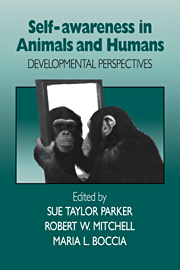Book contents
- Frontmatter
- Contents
- Contributors
- Foreword, by Louis J. Moses
- Acknowledgments
- Note added in proof
- Part I Comparative and Developmental Approaches to Self-awareness
- 1 Expanding dimensions of the self: Through the looking glass and beyond
- 2 Myself and me
- 3 Self-recognition: Research strategies and experimental design
- 4 From self-recognition to theory of mind
- 5 Mutual awareness in primate communication: A Gricean approach
- 6 Multiplicities of self
- 7 Contributions of imitation and role-playing games to the construction of self in primates
- Part II The Development of Self in Human Infants and Children
- Part III Self-awareness in Great Apes
- Part IV Mirrors and Monkeys, Dolphins, and Pigeons
- Part V Epilogue
- Author index
- Subject index
3 - Self-recognition: Research strategies and experimental design
Published online by Cambridge University Press: 24 November 2009
- Frontmatter
- Contents
- Contributors
- Foreword, by Louis J. Moses
- Acknowledgments
- Note added in proof
- Part I Comparative and Developmental Approaches to Self-awareness
- 1 Expanding dimensions of the self: Through the looking glass and beyond
- 2 Myself and me
- 3 Self-recognition: Research strategies and experimental design
- 4 From self-recognition to theory of mind
- 5 Mutual awareness in primate communication: A Gricean approach
- 6 Multiplicities of self
- 7 Contributions of imitation and role-playing games to the construction of self in primates
- Part II The Development of Self in Human Infants and Children
- Part III Self-awareness in Great Apes
- Part IV Mirrors and Monkeys, Dolphins, and Pigeons
- Part V Epilogue
- Author index
- Subject index
Summary
Experimental background
The first experimental test of self-recognition in animals was conducted on a group of preadolescent chimpanzees and several species of monkeys (Gallup, 1970). Initially all of the animals acted as if they were seeing other animals when they looked at themselves in the mirror. After a couple of days, however, the chimpanzees (but not the monkeys) began to respond as if they had come to appreciate the dualism implicit in mirrors and now realized that their behavior was the source of the behavior being depicted in the reflection. That is, rather than responding to the mirror as such with species-typical patterns of social behavior, they began to show self-directed responding by using the mirror to respond to themselves (e.g., to investigate parts of their bodies that they had not seen before). In an attempt to validate my impressions of what had transpired, I devised a more rigorous, unobtrusive test of selfrecognition. After the 10th day of mirror exposure the chimpanzees were placed under anesthesia and removed from their cage. While the animals were unconscious, I applied a bright red, odorless, alcohol-soluble dye (rhodamine-B base) to the uppermost portion of an eyebrow ridge and the top half of the opposite ear. The subjects were then returned to their cages in the absence of the mirror and allowed to recover from anesthetization.
- Type
- Chapter
- Information
- Self-Awareness in Animals and HumansDevelopmental Perspectives, pp. 35 - 50Publisher: Cambridge University PressPrint publication year: 1994
- 27
- Cited by

